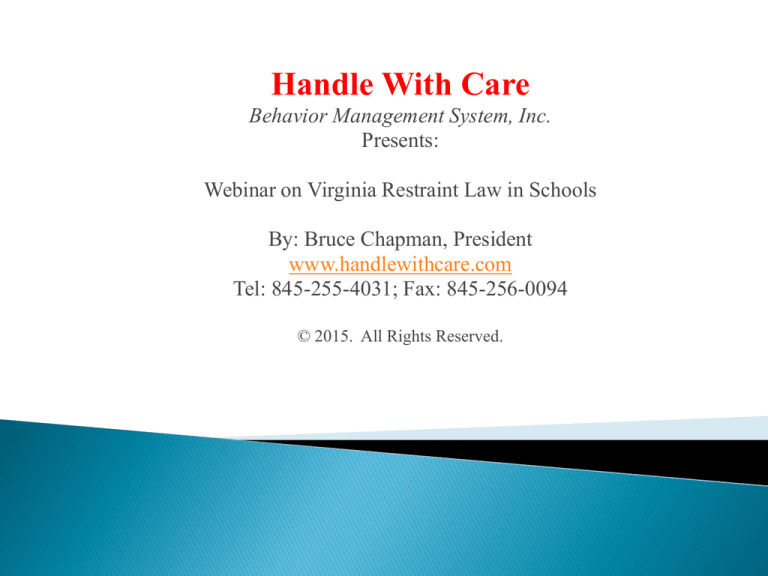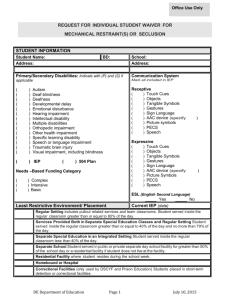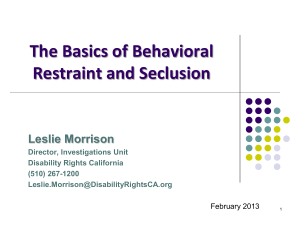
Handle With Care
Behavior Management System, Inc.
Presents:
Webinar on Virginia Restraint Law in Schools
By: Bruce Chapman, President
www.handlewithcare.com
Tel: 845-255-4031; Fax: 845-256-0094
© 2015. All Rights Reserved.
The restraint law enacted in Virginia states:
◦ The School Board shall adopt regulations on the use of seclusion and
restraint in public elementary and secondary schools in the
Commonwealth that:
(i) are consistent with its Guidelines for the Development of
Policies and Procedures for Managing Student Behavior in
Emergency Situations and the Fifteen Principles contained in the
U.S. Department of Education’s Restraint and Seclusion: Resource
Document
(ii) include definitions, criteria for use, restrictions for use, training
requirements, notification requirements, reporting requirements and
follow-up requirements; and
(iii) address distinctions, including distinctions in emotional and
physical development between (a) the general student population
and the special education student population and (b) elementary
school students and secondary school students.
The U.S. DOE identified 15 principles that States, local
school districts, preschool, elementary, and secondary
schools, parents, and other stakeholders should consider
as the framework for when States, localities, and districts
develop and implement policies and procedures, which
should be in writing related to restraint and seclusion to
ensure that
◦ any use of restraint or seclusion in schools does not
occur, except when there is a threat of imminent
danger of serious physical harm to the student or
others, and occurs in a manner that protects the
safety of all children and adults at school.
FIFTEEN PRINCIPLES
1. Every effort should be made to prevent the need for the use
of restraint and for the use of seclusion.
2. Schools should never use mechanical restraints to restrict a
child’s freedom of movement, and schools should never use a
drug or medication to control behavior or restrict freedom of
movement (except as authorized by a licensed physician or other
qualified health professional
3. Physical restraint or seclusion should not be used except
in situations where the child’s behavior poses imminent
danger of serious physical harm to self or others and other
interventions are ineffective and should be discontinued as
soon as imminent danger of serious physical harm to self or
others has dissipated.
4. Policies restricting the use of restraint and seclusion should
apply to all children, not just children with disabilities.
FIFTEEN PRINCIPLES
5.
Any behavioral intervention must be consistent with the child’s rights to be
treated with dignity and to be free from abuse.
6.
Restraint or seclusion should never be used as punishment or discipline (e.g.,
placing in seclusion for out-of-seat behavior), as a means of coercion or retaliation,
or as a convenience.
7.
Restraint or seclusion should never be used in a manner that restricts a child’s
breathing or harms the child.
8.
The use of restraint or seclusion, particularly when there is repeated use for
an individual child, multiple uses within the same classroom, or multiple uses by
the same individual, should trigger a review and, if appropriate, revision of
strategies currently in place to address dangerous behavior; if positive behavioral
strategies are not in place, staff should consider developing them.
9.
Behavioral strategies to address dangerous behavior that results in the use of
restraint or seclusion should address the underlying cause or purpose of the
dangerous behavior.
10. Teachers and other personnel should be trained regularly on the appropriate use
of effective alternatives to physical restraint and seclusion, such as positive
behavioral interventions and supports and, only for cases involving imminent
danger of serious physical harm, on the safe use of physical restraint and seclusion.
FIFTEEN PRINCIPLES
11. Every instance in which restraint or seclusion is used should be carefully
and continuously and visually monitored to ensure the appropriateness of its
use and safety of the child, other children, teachers, and other personnel.
12. Parents should be informed of the policies on restraint and seclusion at
their child’s school or other educational setting, as well as applicable Federal,
State, or local laws.
13. Parents should be notified as soon as possible following each instance in
which restraint or seclusion is used with their child.
14. Policies regarding the use of restraint and seclusion should be reviewed
regularly and updated as appropriate.
15. Policies regarding the use of restraint and seclusion should provide that
each incident involving the use of restraint or seclusion should be documented
in writing and provide for the collection of specific data that would enable
teachers, staff, and other personnel to understand and implement the preceding
principles.
As used in this document, the phrase “dangerous behavior” refers to
behavior that poses imminent danger of serious physical harm to self or others.
U.S. DOE disclaimed its own guidance stating:
“[This guidance is] provided for the user’s convenience. No
official endorsement by the U.S. Department of Education of
any product, commodity, service or enterprise mentioned in
this report or on websites referred to in this report is
intended or should be inferred. The views expressed herein
do not necessarily represent the positions or policies of the
Department of Education and no official endorsement of
them by the Department is intended or should be inferred.”
U.S. Department of Education
Arne Duncan
Secretary
There are two main legal standards for using restraint
or any use of force in a school:
◦ A reasonable person standard when restraint is used in
protection of self, others and property (this standard is
generally codified by Statute under State law).
◦ A treatment/professional judgment standard when restraint is
used pursuant to an IEP or BP, or
Use of physical force in defense of a person.
“[A] person who reasonably apprehends bodily harm
by another is privileged to exercise reasonable force to
repel the assault. Diffendal v. Commonwealth, 8 VaApp
417, 421 (1989).
Use of physical force in defense of others:
The right to defend another “is commensurate with self
defense” Foster v. Commonwealth, 13 Aa. App. 380
(1991).
Legal Standard: Professional Judgment Standard: When
restraint is used as part of an IEP or IBP
◦ Youngberg v. Romeo, 457 U.S. 307 (1982).
This Supreme Court applied a “professional judgment standard” in ruling
that the legal responsibility for making treatment and safety decisions rests
exclusively with our facility professionals who work directly with a given
population and who are best able to 1) determine the clinical, physical and
emotional needs of the client and 2) balance those needs against the overall
safety and security needs of the facility.
◦ Tinker v. Des Moines Ind. Community School Dist., 393 U.S. 503
(1969)
Holding, students [and teachers] do not “shed their Constitutional rights ….
at the schoolhouse gate.”
◦ Conclusion:
◦ When restraint is used for treatment purposes, the lawful standard is, it
must be included in a student’s IEP or IBP. An IEP/IBP relies on the
‘professional judgment’ of the state-licensed professionals who are
acting within the scope of their professional practices and licenses on
behalf of the student. If you are one of the state-licensed professionals
in charge of creating a student’s IEP or IBP, the U.S. Supreme Court
has determined that restraining decisions are within the scope of your
practice and license in the “exercise of [your] professional judgment.”
Because you are directly responsible for the student’s education and
safety, YOU are in the best position to assess the ‘real needs’ of the
student.
The doctrine of “in loco parentis” .
This is a Latin term meaning in place of parents. The legal doctrine
is embedded in common law through Federal and State Court
decisions and in many cases has been codified into law by States.
The doctrine refers to the legal responsibility of a person or
organization to take on some of the functions and responsibilities of a
parent.
According to the Supreme Court, schools act “in loco parentis” for
students in matters relating to school safety, education and discipline.
Ingram v. Wright, 430 U.S. 651 (1977)
Does not specifically mention restraints
Does specifically mention Positive Behavior Intervention Supports.
Has been interpreted as requiring preventative methods like PBIS when
possible before using restraint
The Office for Civil Rights (“OCR”) has recognized and upheld the use
of restraint when done in accordance with a behavioral plan (BP),
individual education plan (IEP) or when necessary to maintain a safe
environment.
Students who require interventions, strategies, supports or restraint to
address behavior should have that included in their IEP or behavior
plan.
When restraints are performed consistent with the student’s IEP or BP
there is no violation of IDEIA
Prohibits discrimination against students with
disabilities.
OCR has interpreted these statutes as requiring schools
to develop behavioral plans for students whose
disability related behavior interferes with their ability
to receive educational benefit or learn.
OCR and Courts have upheld the use of restraint when
it is done to prevent harm, maintain safety or done
pursuant to a behavior plan or IEP.
“Serious physical harm” and “serious bodily harm” are
interchangeable terms that have significant meaning under the
law.
Serious physical harm is defined by statute as “physical injury
that creates a substantial risk of death; extreme physical pain; or
that causes protracted and obvious disfigurement, or protracted
loss or impairment of the function of a bodily member, mental
faculty or organ.” 18 U.S.C. 1365; VA Code 16.1-283. Thus a
teacher following VA Code 22.1-279.1:1 would have to allow an
out-of-control child in her classroom to continue beating another
child, maybe your child, until it reached the threshold of losing
an eye or a limb or the child was about to be permanently
disfigured or killed before intervening physically.
Examples of non-serious injuries as held by the courts
include:
◦ kicking a teacher’s shins and stomping on her toes until both
her legs and feet were red; brain concussion, lacerations that
require stitches, abrasions, bruises, burns, bites, simple
fractures, severe property destruction, joint dislocations, hair
pulls, a temporary loss of consciousness (a “KO”), loss of
hearing, loss of a tooth, bone fractures, stabbing and gunshot
wounds that fall sort of dismembering or injuring a vital organ.
The recent legislation puts schools in a bind.
If schools follow the new legislation:
◦ It violates their employee’s rights to defend self and others
from bodily harm by reasonable means.
◦ It puts employees and students at risk.
◦ Firing or disciplining a person for defending self or others is
against public policy and the school can be sanctioned and
even sued.
◦ The school has the duty to maintain a safe environment
conducive to education. The legislature did not indemnify
schools of this duty.
Request Guidance and Clarification from.
◦ School administrators: superintendent and principal,
◦ School board,
◦ School district
◦ Local law enforcement (municipal, state, local, sheriff)
◦ Local prosecutor, and
◦ State attorney general.
Ask them:
Q1. VA has two different set of laws regarding the use of physical
intervention: The first set allows a person to protect self, others and
property in accordance with a reasonable person’s standard. The second
set of laws restricts school staff from intervening unless student is in
danger of serious physical injury i.e. loss of a limb or organ. Which law
and legal standard will be enforced?
Q2: The legal duty to maintain a safe educational environment
rests with the school. Mandating a serious physical injury
standard means that the school cannot choose more appropriate
intervention policies. What liability indemnification is going to
be provided to schools and its employees? What liability
exposure currently exists if schools follow the new restraint law?
Q3: If a staff member is in danger what standard should she
follow: self defense law or serious physical injury? If the latter,
what additional liability is the school subject to i.e. punitive
damages.
Q4: Is it even lawful for a school to take disciplinary
action or fire an educator or employee for protection
self, others or property in accordance with a reasonable
person standard?
Q5. Is the serious physical injury standard, in cases of
defense of self, others or property, lawful?




